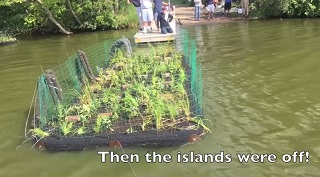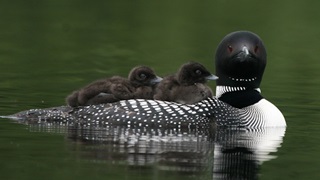Floating a great idea: Man-made islands purify water in Land of 10,000 Lakes
Aitkin County-University of Minnesota project tackles pervasive algal blooms
A small red fishing boat pulls away from the shore of Minnesota’s Fleming Lake, towing behind it an unusual haul—a man-made island.
The boat is captained by Steve Hughes, district manager of the Aitkin County Soil and Water Conservation District (SWCD). It travels to the northeast corner of the 300-acre lake, where three anchors are lowered to hold in place the 50-square-foot floating island.
Fifteen other islands will follow—13 the same size, and two larger ones. Resembling Wisconsin and Minnesota’s natural floating peat bogs, the islands will provide a similar function: they will help clean the lake water.
“Fleming Lake is experiencing problems related to excess nutrients,” Hughes says. “It has a noticeable algae bloom starting early July; there’s a green tint to the water.”
A serious odor accompanies the discoloured water, and, as the algae dies, it uses up oxygen in the water, killing fish.
The nutrients, which are often carried in agricultural or stormwater runoff, enter the lake from the surrounding watershed, Hughes explains. “In Aitkin County, phosphorous is abundant in the soil,” he says. “Runoff carries it into the lake . . . and that’s what we’re trying to solve.”
The floating islands, manufactured by Midwest Floating Island from Minneapolis, are a proven technology when used in smaller bodies of water, such as stormwater ponds.
“This is the first time the islands have been put in such a large area,” Hughes says.
The islands are made of recycled plastic bottles and PET plastic, shredded up and woven together into a seven-inch thick pad. According to the manufacturer, the Fleming Lake project will keep 25,000 bottles out of landfills. Holes are drilled a foot apart through the plastic matrix, with soil is inserted into it.
On Aug. 23, official launch day for the Fleming Lake islands, a team of about 40 bioproducts and biosystems engineering students from the University of Minnesota planted 2,000 aquatic plants native to the area in the islands, capping a year-long research project under the direction of UMN professor Joe Magner.
Hughes says that as the plants grow, their roots will dangle into the water and attract microbes and bacteria that will tie up the excess nutrients so they aren’t floating free in the water.
“The plants growing on the islands will use some of the nutrients and take it out of the water,” Hughes says.
The floating islands project is a partnership between the Aitkin County SWCD and the University of Minnesota. Enbridge’s Ecofootprint Grant Program provided the funding, with a contribution of $101,500.
“This project has a water quality component as well as a research component,” says Cindy Finch, Enbridge’s senior public affairs advisor based in Duluth-Superior.
“It will help clean the lake water for recreational and environmental purposes, and the researchers will track the progress of the plants, monitoring their growth and effectiveness at removing algae.”
Says Hughes: “We hope these islands do exactly what they need to do.”
(TOP PHOTO: University of Minnesota bioproducts and biosystems engineering students create one of 16 floating islands later launched into Fleming Lake.)










